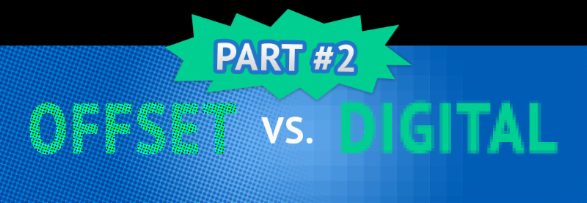

|
Offset vs. Digital Printing - What's the Difference? Part 2
|
|
PART 2: DIGITAL PRINTING
In our last newsletter, we covered offset printing and its key benefits and features.
In this issue, we'll talk about digital printing. If you look at a digital press and an offset press side-by-side, you'll see a difference right away. Offset equipment is recognizable as a traditional printing press. Digital presses look more like very large copiers. It makes sense: they print from digital files. There are no printing plates and no rubber blankets with digital, as there are with offset. Offset presses use ink. Digital presses use either toner or liquid ink. The technology is totally different.
What really matter to customers are the benefits and characteristics of digital printing.
|
|
Benefits of Digital Printing
1. Perfect for small print runs - When you print digitally, you can print just one copy and be done. It's ideal for short runs, like 500 flyers or 100 invitations. Producing these digitally will be more cost-effective than printing them offset.
2. No wasted copies - Because you only print what you need, there's no waste. Digital is a "green" process: no film, no plates, no photo-chemicals, and no wasted inventory.
3. Faster turnaround time - Digital presses don't have "make ready" time that offset presses do. Once a file's approved to print, off it goes - and your print job is produced very quickly. If you need a job printed at the last minute, digital is the only way to go.
4. Proofing can be quicker - You won't go "press-side" to check a digital job. We'll send you a digital proof or, if a hard copy is preferred, we'll send you a copy on the actual paper stock.
5. Variable data capabilities - Digital printing is perhaps best known for its ability to personalize your print job by marrying a data file with the design template. Every copy that's printed can be unique, by incorporating all kinds of information from a customer database. Picture a marketing campaign that's tailored to your entire mailing list, based on data like demographic information. Send recipients in California a brochure with different images than you send to people in New England. You can change copy, images, codes, numbering, and the color palette on every print job. You can't do this with offset.
|
|
Characteristics of Digital Printing
1. Limited paper options - While there are more paper choices all the time. The available options are still not as extensive as for offset presses.
2. Limited format options - Size matters with digital, as it typically offers smaller formats than offset presses. The same goes for finishing options and special inks.
3. Quality isn't quite the same as offset - Most people won't be able to discern any quality difference, but print purists claim that they can detect the "dots" on a digitally printed job.
4. Spot colors are a CMYK mix - Most digital presses use the four process colors only, not Pantone® colors. If you want a spot color, it will be a blend of CMYK.
|
|
In a nutshell, these are the key features and characteristics
of DIGITAL PRINTING.
Think of going digitally when you need a job produced fast, when you only need a small quantity, or when you want to personalize your job using variable data.
We do a significant amount of digital printing at PrintTech. Don't hesitate to consult with us if you're uncertain about going digital vs. offset. We'll discuss what makes sense and what you can and can't do with either method.That's our specialty: helping customers make the best choice!
|
